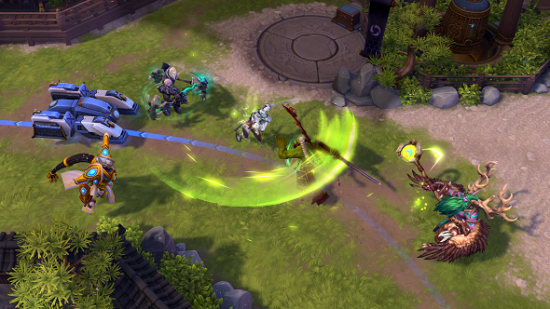After a successful first stint with Tracer, Zarya and Lucio, another Overwatch character is heading to Heroes of the Storm. Perpetual pub-star and heal-requiring robot-samurai Genji will be making his presence felt on backlines everywhere. He’ll be doing so in his home zone of Hanamura, which has changed into a payload map during the transition to lanes and cores. Having played several games, both are minty fresh additions of the kind Heroes players have come to expect from their patches.
The last hero added to Heroes of the Storm was Cassia, the Javazon.
Let’s start with the tin can kid himself.
Genji brings his signature team-destroying power and mobility to Heroes of the Storm
Porting Overwatch characters to Heroes is one of the easier production schedules for the Blizzard team, the two games sharing a mighty amount of DNA. However, while this makes it simple(r) to design a basic kit, it adds an extra demand of the character needing to feel like their payload-pushing, point-capturing FPS counterpart.
“We [tried] to bring the core experience of Genji from Overwatch into Heroes directly and then make changes and updates as needed,” explains Matt Cooper, lead live designer who worked on Genji and handles balance for Heroes in general. “Of course, we have the talents system and the second heroic ability that require a lot of design space and a lot of iteration.”
In Genji’s case, what this means is a high skill cap character who can devastate teams in the right circumstance, but is fragile when caught. The Heroes team have pulled that off perfectly. Going huge with Genji in Heroes feels exactly the same as that perfect Dragonblade team kill in Overwatch, with the added benefit of getting to see it all play out from overhead. With its lack of items and individual hero levels, it’s harder for Heroes to generate those ‘I’m the star’ moments that carried MOBAs to such incredible popularity, but Genji manages it.
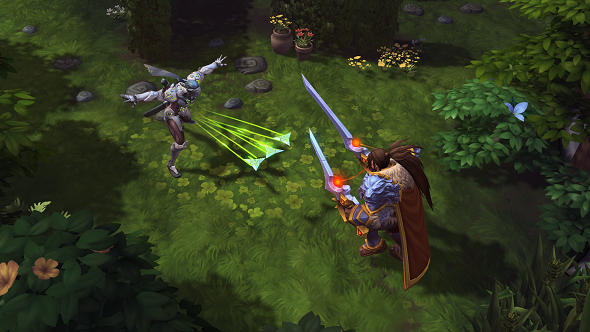
He fits into the ranged assassin archetype, shooting off bursts of three shuriken with basic attacks. Health, mana and right clicking work similarly to any other hero, none of Tracer’s ammo gimmick here, but the core of his successful transfer is how his abilities have been moved over. Here’s a run-down on those:
- Cyber-Agility (D): A short jump that can take Genji over terrain and other obstacles.
- Shuriken (Q): Fires three shuriken simultaneously in a spread. All three can hit the same target. This ability has three charges and a relatively long cooldown, but all three charges are restored simultaneously.
- Deflect (W): Puts Genji into a protected state where all damage is ignored, though crowd control still affects him. Every time damage is ignored, a blade is thrown at the nearest enemy hero within a medium range.
- This blade does the same damage no matter the original source – standing in a constantly ticking AOE is going to put serious hurt on opponents.
- Swift Strike (E): A dash attack that deals damage along its line. Takedowns on heroes that have recently been hit by Swift Strike will reset its cooldown and refund its mana cost.
- Dragonblade (R1): Genji’s signature ultimate, he draws his massive sword and goes on a spree. Reactivating this ability allows Genji to slash in a massive arc, moving him slightly forward as he does so. This can be done several times over a short duration, doing huge damage each time. Takedowns on heroes recently hit by Dragonblade also reset Swift Strike.
- X-Strike (R2): A new ability for Heroes of the Storm, this is a more AOE-focused choice for Genji, dealing damage in a large X shape after casting, followed by a short delay and another large chunk of damage in the same area. During the initial cast, Genji is not on the map and is immune to everything.
As you can no doubt imagine, all of this combines very well to get that flowing, endlessly damaging playstyle going. Against single target’s he’s a monster, while in team fights he can’t be ignored.
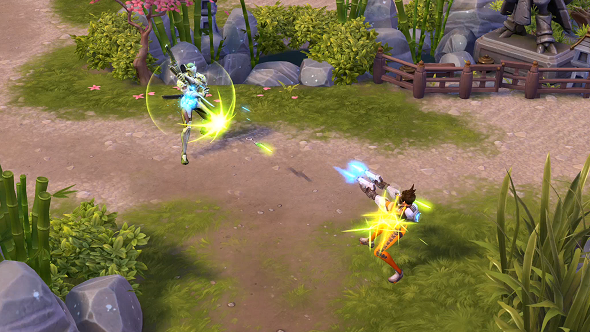
“We balance the game to try and have every hero have a unique role and for every hero to be very effective so we did want to bring over the fact that Genji can live out those heroic moments,” says Cooper. “That’s why Swift Strike and Dragonblade can reset his mobility and he can go on some of those moments – but it’s not going to be something you can experience all the time.”
On the specifics of bringing him over, Cooper is obviously happy with the final result, but it took some work. “We did have some challenges with his Q ability, the shurikens. Interestingly enough, when we had Dragonblade in the game and we implemented the second heroic, X-Strike, everyone on the design team was purely using X-Strike. We had to look at Dragonblade and go ‘we know this is an awesome ability from Overwatch, we know this can work’ – we had to look at doing a lot of balance changes and tuning changes to actually bring Dragonblade up to make it kinda compete with X-Strike.”
If anything, they may have pushed things too far the other way, though the balance there – both in terms of pure numbers tuning and trying to make another heroic ability when the first is ‘canonical’ – is tough. Dragonblade feels like it meshes better with the rest of his kit because I already understand its place after so many hours of Overwatch, while X-Strike is a more traditional MOBA AOE.
The various 5v5 games we got in proved he was strong, but it’s harder to tell specifics from matches with such a wide variety of skill levels as those found at a press event. Over to Cooper, then, for how the Blizzard team have found he fits at a higher level.
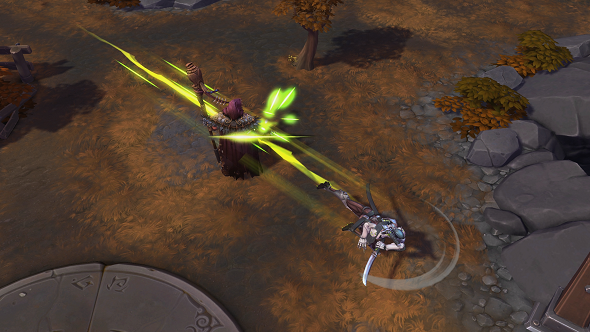
“We’ve found that he definitely excels on battlegrounds where players are a bit more spread out, battlegrounds that are maybe a little bit larger, because he’s better at going on to a single character – you’re not going to outrun him, right?
“In terms of hero pairings, we’ve found that Genji is not necessarily going to jump into the middle of a team and get a takedown on someone from 100% to zero so instead he kinda needs his team to provide a lot of poke damage, a lot of ranged damage, wear down the enemy team, maybe get them to half health, and then he can try and go in and get that kill and get out.”
To that I’d add that in a standard teamfight where both sides have decided to go all-in, he’s as powerful as you would expect. Swift Striking through multiple enemies for large amounts of damage, dashing to backlines quickly, all while swinging Dragonblade around like it’s going out of style, he matches up with the best of them. You’re better off going in with an advantage, and Genji can secure that too, with early game movement options and wall-jumps thanks to Swift Strike and his trait.
As for stopping him, that pulls from Overwatch too – lock Genji down and he’s a relatively fragile pile of robo-bones. To get him dead you’ll need for deflect to be out of the way, and slows won’t do it if Swift Strike is off cooldown, but once you can actually get the right clicks and nukes in he’ll evaporate as quickly as anyone. My Heroes workhorse of choice, Varian, was particularly effective, here’s Cooper’s suggestions:
“Hard crowd control is a good option. Internally, one of our designers would pick Muradin a lot to counter Genji. He’d [take] the skullcracker talent, if you land your storm bolt he’s in trouble, if you land an auto attack he’s in trouble because it also stuns him, cancels his deflect, locks him in place. And if he doesn’t get that takedown for his Swift Strike right away, he can’t use it again and it’s on a pretty long cooldown. He’s kinda stuck there with his pants down.”
Therefore, holding objectives may not be Genji’s forté. Thankfully, his home map combines both movement and capturing – pushing the cart comes to Heroes of the Storm.
Hanamura introduces a totally new game type to Heroes, combining the best elements of previous maps
3.png)
Certainly the heaviest fighter in Heroes’ corner in the Great MOBA Brawl 2k17 (apart from the speed of matches) is the variety in maps. It fuels everything, from hero diversity to that extra bit of skill-testing flavour. Hanamura follows that trend, adding payloads to push in the formula of a Towers of Doom-style map – that is, one where it is impossible to directly attack the enemy core.
Instead, each payload delivered to its destination fires a cannon at the opposing base, dealing a point of damage. Destroyed towns increase your next payload hit by one, and a boss mercenary can do a bunch of damage all in one go if you can take him down. Like the other mercs on the map, he’s a totally new design, a giant samurai robot that can eat heroes for a short period to totally take them out of a fight.
Those other mercs, with lane pushing being of lower value than normal, drop power-ups rather than becoming capturable superpowered minions. Each camp drops a different one, be it recon dragon spirits that seek out the nearest enemy heroes and reveal them, a large AOE heal that leaves a large HOT on those nearby or a placeable turret. That turret can even be placed on your payloads to give them an extra bit of oomph.
The payloads themselves spawn for each team at the same time, taking various paths through the map. These can intersect with the two lanes (north and south), take it near mercenary camps, or even pass right by each other – or avoid completely. The more people on a payload the faster it moves, up to a max of three, while just one enemy nearby will stop its progress. It’s up to your team as to how many people to send to each, while keeping in mind XP, gathering powerups and more.
4.png)
“Towers of Doom was a bit of an experiment, right? It was the first time we had tried that out,” says Cooper of one of Heroes’ most controversial designs. “Early on we got a lot of critical feedback that maybe it was snowbally or that the mechanic wasn’t that fun and I think over time it kinda grew on players, they realised it was a really fun way to play Heroes of the Storm. We definitely wanted to do more mechanics where you weren’t always going down the lane and winning by taking mercs and capturing the core, right? We wanted that different gameplay experience.
“Then going into the payloads, [we created] a lot of decision making for players. So it’s not simply about just pushing your payload and that’s all you have to do – might be multiple payloads, the enemies have payloads, there’s a lot going on.”
The multiple payloads per side sometimes come into play towards the middle of a match, making it so getting stuck unable to push is less likely. Payloads have no natural healing aura – Cooper says it lead to some unfun gameplay, as did payloads blocking skillshots – so one team finishing first means the other needs to win a teamfight to keep theirs going. Getting around is important, and movement tools are especially useful as much of the map is wide open.
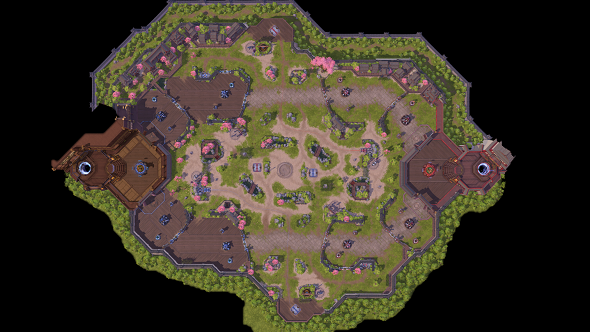
“I think duelist characters, ones you might bring top-lane on Braxis Holdout like Leoric or Alarak, someone who can be very independent, are great on this battleground. You can have that player spend most of their [time] in a lane and fight over a payload to deny it, while the rest of the team can fight over the other payloads.
“We found Chromie to be very effective because you know where a bunch of players are standing, and they have to stay near their payload so you can use her Slowing Sands heroic ability, and of course you can just [hit] people from a very long distance and just whittle them down.”
It’s great fun, and feels as different from other Heroes maps as Heroes itself does from its competitors. It was extremely quick in my matches, no game hitting level 20 before it ended. Cooper says that isn’t what Blizzard have found in testing, but they’re more than willing to keep things changing in the beta phase.
Heroes of the Storm continues to define itself with its differences, and according to the Heroes 2.0 timeline, there’s more to come over the next couple of months. Hopefully, Heroes can continue to leverage the strength of other Blizzard games for its own success.
